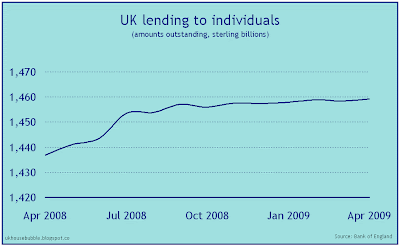 Does this chart, illustrating the total stock of household debt, represent success or failure of government policy?
Does this chart, illustrating the total stock of household debt, represent success or failure of government policy?In April 2009, the total outstanding stock of lending to individuals stood at ₤1,459,181,000,000. That is a very big number, and it is the equivalent of about 100 percent of GDP. Over the previous twelve months, that number increased 1.6 percent. So, despite the credit crunch, the recession and declining average earnings, household indebtedness is actually increasing.
Since the state aim of government policy was to maintain the flow of credit, should the government feel satisfied with today's numbers? Unfortunately, household debt did not grow fast enough to keep the real economy growing. In previous years, household debt increased at double digit rates, allowing personal consumption to grow and maintain high levels of GDP growth. A 1.6 percent growth of debt simply isn't fast enough.
However, if the objective of government policy is to create the conditions for sustainable growth, then the government has failed at a more fundamental level. An country can not thrive as its people sink further into debt. Sooner or later, the debt needs to be paid off.
2 comments:
I don't know about the UK, but in the US the attitude up to 1970 was "die with money in the bank so you can pass it on to loved ones to help them live a better life"... and it changed by 1980 to "He who dies in debt wins."
Very sad.
You can't run a consumer economy on debt forever. At some point the lenders refuse to lend any more and want the rest back. Welcome to the next decade (or two).
Post a Comment